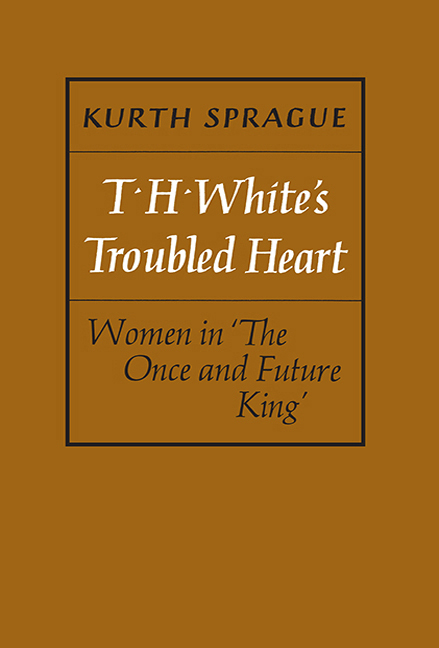Book contents
- Frontmatter
- Dedication
- Contents
- Miscellaneous Frontmatter
- Acknowledgements
- Foreword T. H. White Holdings at the Harry Ransom Center
- Preface
- Introduction
- Chapter One T.H. White
- Chapter Two Constance White
- Chapter Three White's Sources
- Chapter Four Omitted and Minor Characters
- Chapter Five Morgause
- Chapter Six Guenever
- Conclusion
- Appendixes
- Notes
- Survey of Criticism on White
- Bibliography
Chapter Two - Constance White
Published online by Cambridge University Press: 11 May 2017
- Frontmatter
- Dedication
- Contents
- Miscellaneous Frontmatter
- Acknowledgements
- Foreword T. H. White Holdings at the Harry Ransom Center
- Preface
- Introduction
- Chapter One T.H. White
- Chapter Two Constance White
- Chapter Three White's Sources
- Chapter Four Omitted and Minor Characters
- Chapter Five Morgause
- Chapter Six Guenever
- Conclusion
- Appendixes
- Notes
- Survey of Criticism on White
- Bibliography
Summary
Constance White was the most important figure in her son's life. She caused his distrust of women and his inability to come to grips with the demands of heterosexual love. She either caused or enhanced his fascination with physical pain and cruelty and the attraction he came to feel for sadism. Less profoundly perhaps, but no less certainly, she provided, through her own intelligence and self-expression, an example that inspired much that was good in his own writing. It is revealing of Constance White's powerful and multifaceted personality that she was able to maim her son's sexual character at the same time as she influenced the commencement of his art; in neither case did she act consciously, nor did the conflict in her roles arouse any sense of self-contradiction in her contradictory nature. Very likely if she was aware later of her effect, she evaded responsibility for the maiming and took credit for the inspiration. But they are both hers. The purpose of this chapter, using material from Constance White's unpublished journals, is to cast some light on both the inspiration and the nature and the extent of the maiming.
Constance Aston White (?1875–1952) was the daughter of an Indian Judge. Of French and Scottish bloodlines, she was, according to her son, a beautiful woman who in her youth attracted many admirers. She seems to have travelled a good deal when she was growing up, mainly in the company of her mother, with whom she did not get on well. She had at least a smattering of languages, and played the piano expertly enough to be asked to give a concert. She had little knowledge or interest in what went on in the kitchen. Servants were plentiful in those days; most probably they were a perquisite of the judge's position, like the privilege of keeping confiscated murder weapons. The Astons do not appear to have been people of any great means although they lived well and, upon their retirement, bought a house large enough to delight the four rampaging grandchildren whom they raised. One has the impression in reading her memoirs that Constance White's early life was a circumscribed round of tennisparties, teas, thés dansants, afternoon drives, and dinner parties—all in the company of safe civil servants and professional military families: she complains that she never found herself in the company of cultured people.
- Type
- Chapter
- Information
- T. H. White's Troubled HeartWomen in <I>The Once and Future King</I>, pp. 33 - 46Publisher: Boydell & BrewerPrint publication year: 2007

